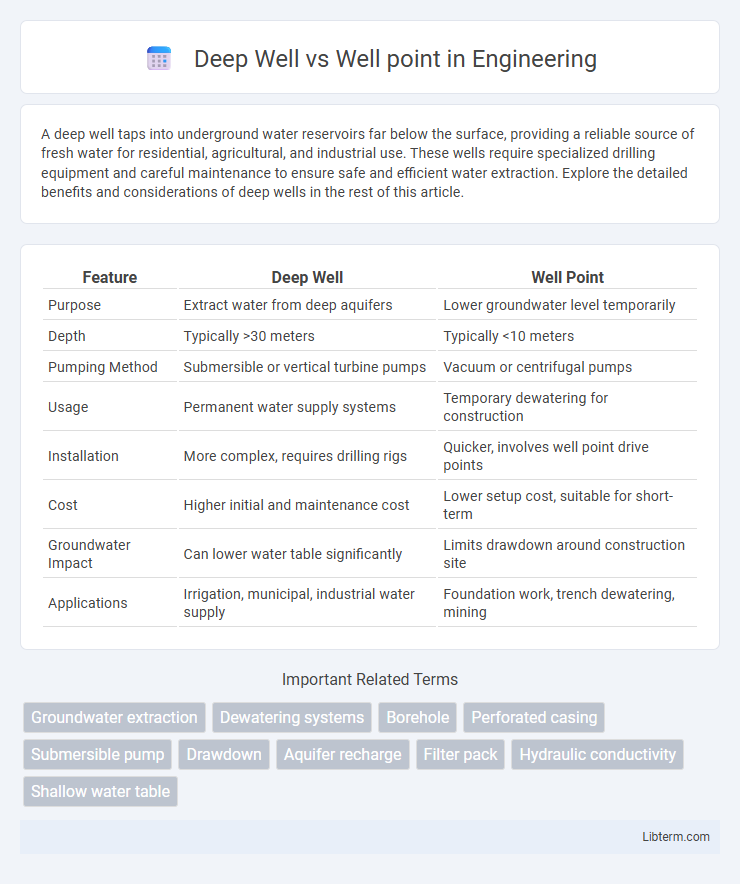A deep well taps into underground water reservoirs far below the surface, providing a reliable source of fresh water for residential, agricultural, and industrial use. These wells require specialized drilling equipment and careful maintenance to ensure safe and efficient water extraction. Explore the detailed benefits and considerations of deep wells in the rest of this article.
Table of Comparison
| Feature | Deep Well | Well Point |
|---|---|---|
| Purpose | Extract water from deep aquifers | Lower groundwater level temporarily |
| Depth | Typically >30 meters | Typically <10 meters |
| Pumping Method | Submersible or vertical turbine pumps | Vacuum or centrifugal pumps |
| Usage | Permanent water supply systems | Temporary dewatering for construction |
| Installation | More complex, requires drilling rigs | Quicker, involves well point drive points |
| Cost | Higher initial and maintenance cost | Lower setup cost, suitable for short-term |
| Groundwater Impact | Can lower water table significantly | Limits drawdown around construction site |
| Applications | Irrigation, municipal, industrial water supply | Foundation work, trench dewatering, mining |
Introduction to Deep Wells and Well Points
Deep wells are drilled into underground aquifers to extract water from significant depths, often exceeding 100 feet, using submersible pumps to ensure high water yield and sustained supply. Well points consist of a series of small-diameter pipes with screened ends, installed shallowly around construction sites to lower groundwater temporarily, primarily for dewatering purposes in excavation projects. Deep wells provide long-term water access in agricultural and municipal applications, whereas well points are crucial for managing groundwater levels during construction and short-term water extraction.
Defining Deep Well Systems
Deep well systems refer to mechanical pumps designed to extract groundwater from significant depths, often ranging from 50 to over 1,000 feet, making them suitable for agricultural irrigation and municipal water supply. These systems typically involve submersible pumps installed inside a narrow casing pipe, enabling efficient water extraction from deep aquifers. Compared to well point systems, which are shallow and used for dewatering in construction sites, deep well systems provide a reliable solution for high-volume water withdrawal in deep subterranean conditions.
Understanding Well Point Systems
Well point systems consist of a series of small-diameter wells connected to a header pipe and vacuum pump, designed primarily for dewatering shallow excavations by lowering the groundwater level. Deep wells, in contrast, are larger-diameter wells equipped with submersible pumps, capable of removing water from greater depths and higher volumes in construction and mining projects. Understanding well point systems involves recognizing their effectiveness in controlling groundwater temporarily in sandy or granular soils, ensuring stable excavation conditions without extensive infrastructure.
Key Differences Between Deep Wells and Well Points
Deep wells penetrate hundreds of feet below the surface to access groundwater from confined aquifers, providing high-capacity water extraction for industrial or municipal use. Well points are shallow, typically less than 30 feet deep, and function by creating localized suction to lower the water table for construction dewatering or short-term projects. The primary differences lie in depth, pumping capacity, installation complexity, and typical applications, with deep wells suited for sustained water supply and well points for temporary groundwater control.
Installation Process: Deep Well vs. Well Point
The installation process for deep wells involves drilling much deeper into aquifers using rotary or percussion rigs to access reliable groundwater sources, requiring casing and well screens to prevent contamination. Well points are installed through shallow, driven pipe systems connected to a header pipe, ideal for dewatering or accessing shallow groundwater quickly but limited in depth and yield. Deep wells demand more specialized equipment and longer setup time compared to the simpler, faster installation of well points suitable for temporary or small-scale water extraction.
Water Yield and Efficiency Comparison
Deep wells generally offer higher water yield due to their access to larger, more sustainable aquifers, allowing consistent extraction even during dry periods. Well points, designed for shallow groundwater access, have lower efficiency and limited yield, making them suitable for temporary or low-demand water supply. The efficiency of deep wells also benefits from advanced pumping technology, reducing energy consumption compared to well points in similar conditions.
Cost Considerations for Each System
Deep wells typically involve higher installation costs due to the need for specialized drilling equipment and deeper excavation, ranging from $15,000 to $30,000 depending on depth and location. Well points, being shallow and simpler to install, cost significantly less, usually between $2,000 and $5,000, making them ideal for temporary or low-capacity dewatering projects. Maintenance expenses for deep wells can also be higher because of pump servicing and potential well rehabilitation, whereas well points have lower upkeep but shorter operational lifespan.
Maintenance Requirements: Deep Wells vs. Well Points
Deep wells typically require less frequent maintenance due to their deeper, more stable water sources and robust construction, while well points demand regular inspection and cleaning to prevent clogging from surface contaminants and sediment buildup. Well points are more susceptible to pump wear and corrosion, necessitating frequent monitoring to ensure efficient operation. Maintenance protocols for deep wells mainly involve periodic equipment checks and water quality testing to avoid operational issues over time.
Best Applications and Suitability
Deep wells provide reliable groundwater extraction for agricultural irrigation, municipal water supply, and industrial processes requiring high volumes and greater depths. Well points are best suited for dewatering shallow excavation sites, construction projects, and temporary water control due to their ease of installation and lower cost. The suitability depends on the depth of the water table, volume of water needed, and the purpose of extraction or dewatering.
Choosing the Right System for Your Needs
Choosing between a deep well and a well point system depends on your water source and soil conditions. Deep wells are ideal for accessing groundwater from greater depths, offering higher water yields and consistent flow for agricultural or residential use. Well point systems suit shallow groundwater extraction in sandy or loose soils, providing a cost-effective solution for short-term dewatering or irrigation needs.
Deep Well Infographic

 libterm.com
libterm.com